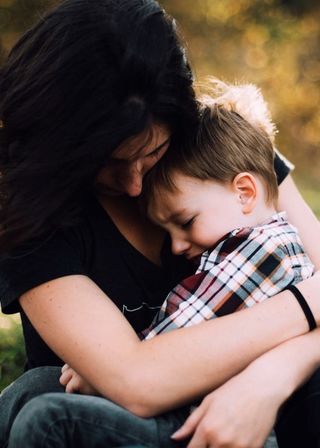Trauma
4 Steps for Discussing Traumatic Events with Children
Because it is important to “speak the unspeakable.”
Posted August 15, 2019

Written by: Shealyn S. May, BA & Dillon T. Browne, Ph.D.
We try to protect children from upsetting events. But traumatic events such as the recent mass shootings in El Paso, Texas and Dayton, Ohio occur and, despite our best efforts, children are exposed to distressing or frightening experiences.
Witnessing traumatic events, such as acts of violence, a natural disaster, or accident, can challenge a child’s sense of security and views of the world. That being said, it is definitely possible for parents to recreate a sense of safety and security following trauma.
What can you do when your child is exposed to a distressing event?
So, an upsetting event has occurred and your child is showing signs of distress (e.g., clinginess, anxiety, withdrawal, etc.). What can you do? A great place to start is by talking to your child in a calm, attentive, and face-to-face fashion. This can provide them with a better understanding of the event and can help them feel supported and protected. The American Academy of Pediatrics (AAP; 2018) encourages parents to “filter information about the crisis and present it in a way that their child can accommodate, adjust to, and cope with”.
How do we talk to children about upsetting things that happen?
Step 1: Set the stage and discuss the event as a family.
Begin by preparing to give your child your full attention. Put away distractions, such as cell phones, and find a space where the conversation can be the main focus. Remind your child you are there to support them, keep them safe, and want to know how they are doing. It may be wise to involve the entire family and allow every person an opportunity to share. This helps individuals overcome isolation and opens the channels of communication throughout the whole family.
Step 2: Start the conversation and gain insight into your child’s understanding of the event.
No matter what age your child is, always start the discussion by asking your child what they already know. Just because your child is not talking about the event, does not mean they are not thinking about it. Try prompting your child by asking, “So how do you feel about what happened at school/down the road/in the world/etc.?” then listen to your child and pay attention for any underlying fears or concerns. Do not force your child to discuss the event. Sometimes, your child may seem disinterested in discussing an upsetting event. This is okay—they hear you and will find security in the space you created.
Step 3: Explain the event to your child in an age-appropriate manner and address inaccuracies.
Once you have insight into your child’s knowledge on the event, explain the event as simply and directly as possible, appropriate for their level of understanding. Avoid frightening or gory details, as these are not necessary for the conversation. However, do not leave out important details or talk about the event inaccurately. It could hinder communication if they discover you have misrepresented the event.
Children are curious and often complete their understanding of events with their imagination or lived experiences. It is crucial that you guide them to an accurate depiction of the event in child-appropriate language (e.g., “people were hurt, someone hurt people, there was an accident, etc.”). Following a traumatic event, it is common for children to place blame on themselves and see the world as a threatening place. Parents can address this personal feeling of responsibility (i.e., “it wasn’t your fault”).
Step 4: Encourage questions and ongoing discussion, while emphasizing love and safety.
Encourage your child to ask questions and provide answers as directly as possible. Moving forward, keep this communication channel open and continue to discuss the event when prompted by your child for as long as is necessary to complete your child’s understanding of the event. Increasing your presence with your child both physically and emotionally can be beneficial. Also, remind them that they are totally loved as they are and that you do everything you can to keep them safe.
Tip 1: Use technology to assist the conversation and monitor your child’s exposure. Consume media coverage surrounding the event as a family if you think it will be beneficial to the discussion and your child’s understanding. If you do, preview the content before and present content you approve of to your child in a manner that allows you to control their consumption (e.g., record the TV news program). This allows for the information to be digested with the opportunity to pause and ask questions, skip graphic details or images, and remove the content if it is distressing your child.
Tip 2: Be mindful of your own responses. Children look to their caregivers in times of crisis for direction on how to respond. If you are distressed by the event, it is important for you to seek support for yourself. Share your own feelings with your child (age appropriately, e.g. “it makes mommy/daddy sad too”). This can facilitate bonding and provide a chance for your child to learn about the emotional experiences of others. Try not to be overprotective. It is natural to want to jump into hyper-protection mode after a child has been exposed to an upsetting event, providing repeated reassurance. But over-protection can cause children to perceive the world as unsafe and frightening. Remember to be patient and remain calm.

Unfortunately, distressing events happen all too often, and children of all ages can be exposed. However, we can be there to guide children’s understanding while promoting safety. Through these conversations, children will receive a critical message: It is okay to be bothered by upsetting events and you will always be there for support because you love them so very much.
References
American Academy of Pediatrics. (2011, September 2). Responding to children’s emotional needs during times of crisis. Retrieved from https://www.healthychildren.org/English/healthy-living/emotional-wellne…
American Academy of Pediatrics. (2018, May 25). Talking to children about tragedies & other news events. Retrieved from https://www.healthychildren.org/English/family-life/Media/Pages/Talking…
Better Health Channel. (2011, December). Trauma and children – Tips for parents. Retrieved from https://www.betterhealth.vic.gov.au/health/healthyliving/trauma-and-chi…
Zero to Three. (2012, April 20). Helping young children cope after exposure to a traumatic event. Retrieved from https://www.zerotothree.org/resources/1094-helping-young-children-cope-…




